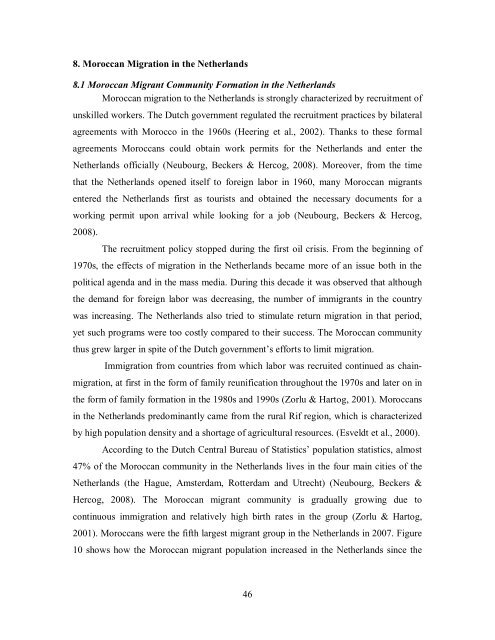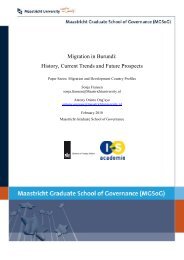Migration in Morocco: History, Current Trends and Future ... - MGSoG
Migration in Morocco: History, Current Trends and Future ... - MGSoG
Migration in Morocco: History, Current Trends and Future ... - MGSoG
Create successful ePaper yourself
Turn your PDF publications into a flip-book with our unique Google optimized e-Paper software.
8. Moroccan <strong>Migration</strong> <strong>in</strong> the Netherl<strong>and</strong>s<br />
8.1 Moroccan Migrant Community Formation <strong>in</strong> the Netherl<strong>and</strong>s<br />
Moroccan migration to the Netherl<strong>and</strong>s is strongly characterized by recruitment of<br />
unskilled workers. The Dutch government regulated the recruitment practices by bilateral<br />
agreements with <strong>Morocco</strong> <strong>in</strong> the 1960s (Heer<strong>in</strong>g et al., 2002). Thanks to these formal<br />
agreements Moroccans could obta<strong>in</strong> work permits for the Netherl<strong>and</strong>s <strong>and</strong> enter the<br />
Netherl<strong>and</strong>s officially (Neubourg, Beckers & Hercog, 2008). Moreover, from the time<br />
that the Netherl<strong>and</strong>s opened itself to foreign labor <strong>in</strong> 1960, many Moroccan migrants<br />
entered the Netherl<strong>and</strong>s first as tourists <strong>and</strong> obta<strong>in</strong>ed the necessary documents for a<br />
work<strong>in</strong>g permit upon arrival while look<strong>in</strong>g for a job (Neubourg, Beckers & Hercog,<br />
2008).<br />
The recruitment policy stopped dur<strong>in</strong>g the first oil crisis. From the beg<strong>in</strong>n<strong>in</strong>g of<br />
1970s, the effects of migration <strong>in</strong> the Netherl<strong>and</strong>s became more of an issue both <strong>in</strong> the<br />
political agenda <strong>and</strong> <strong>in</strong> the mass media. Dur<strong>in</strong>g this decade it was observed that although<br />
the dem<strong>and</strong> for foreign labor was decreas<strong>in</strong>g, the number of immigrants <strong>in</strong> the country<br />
was <strong>in</strong>creas<strong>in</strong>g. The Netherl<strong>and</strong>s also tried to stimulate return migration <strong>in</strong> that period,<br />
yet such programs were too costly compared to their success. The Moroccan community<br />
thus grew larger <strong>in</strong> spite of the Dutch government’s efforts to limit migration.<br />
Immigration from countries from which labor was recruited cont<strong>in</strong>ued as cha<strong>in</strong>-<br />
migration, at first <strong>in</strong> the form of family reunification throughout the 1970s <strong>and</strong> later on <strong>in</strong><br />
the form of family formation <strong>in</strong> the 1980s <strong>and</strong> 1990s (Zorlu & Hartog, 2001). Moroccans<br />
<strong>in</strong> the Netherl<strong>and</strong>s predom<strong>in</strong>antly came from the rural Rif region, which is characterized<br />
by high population density <strong>and</strong> a shortage of agricultural resources. (Esveldt et al., 2000).<br />
Accord<strong>in</strong>g to the Dutch Central Bureau of Statistics’ population statistics, almost<br />
47% of the Moroccan community <strong>in</strong> the Netherl<strong>and</strong>s lives <strong>in</strong> the four ma<strong>in</strong> cities of the<br />
Netherl<strong>and</strong>s (the Hague, Amsterdam, Rotterdam <strong>and</strong> Utrecht) (Neubourg, Beckers &<br />
Hercog, 2008). The Moroccan migrant community is gradually grow<strong>in</strong>g due to<br />
cont<strong>in</strong>uous immigration <strong>and</strong> relatively high birth rates <strong>in</strong> the group (Zorlu & Hartog,<br />
2001). Moroccans were the fifth largest migrant group <strong>in</strong> the Netherl<strong>and</strong>s <strong>in</strong> 2007. Figure<br />
10 shows how the Moroccan migrant population <strong>in</strong>creased <strong>in</strong> the Netherl<strong>and</strong>s s<strong>in</strong>ce the<br />
46



